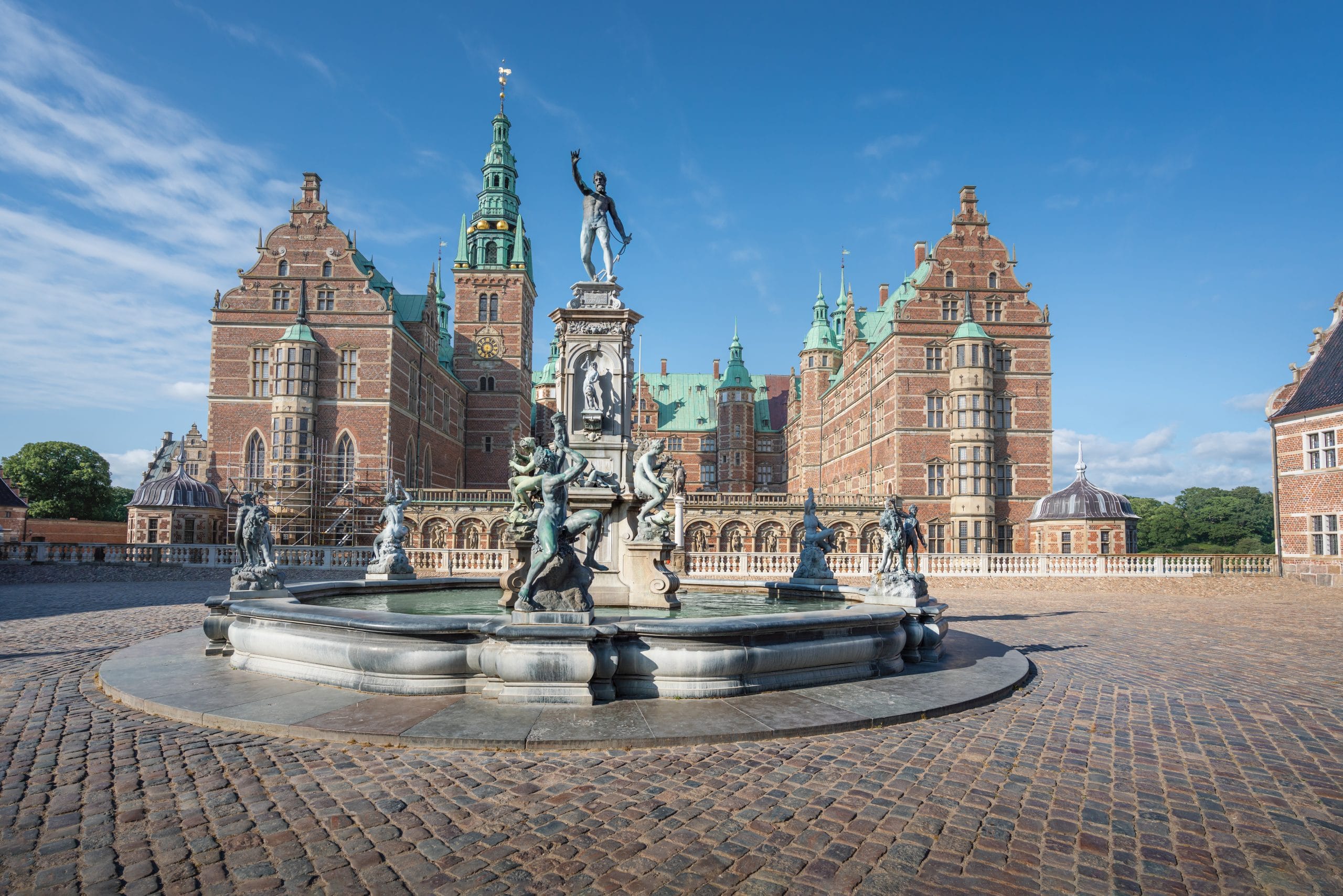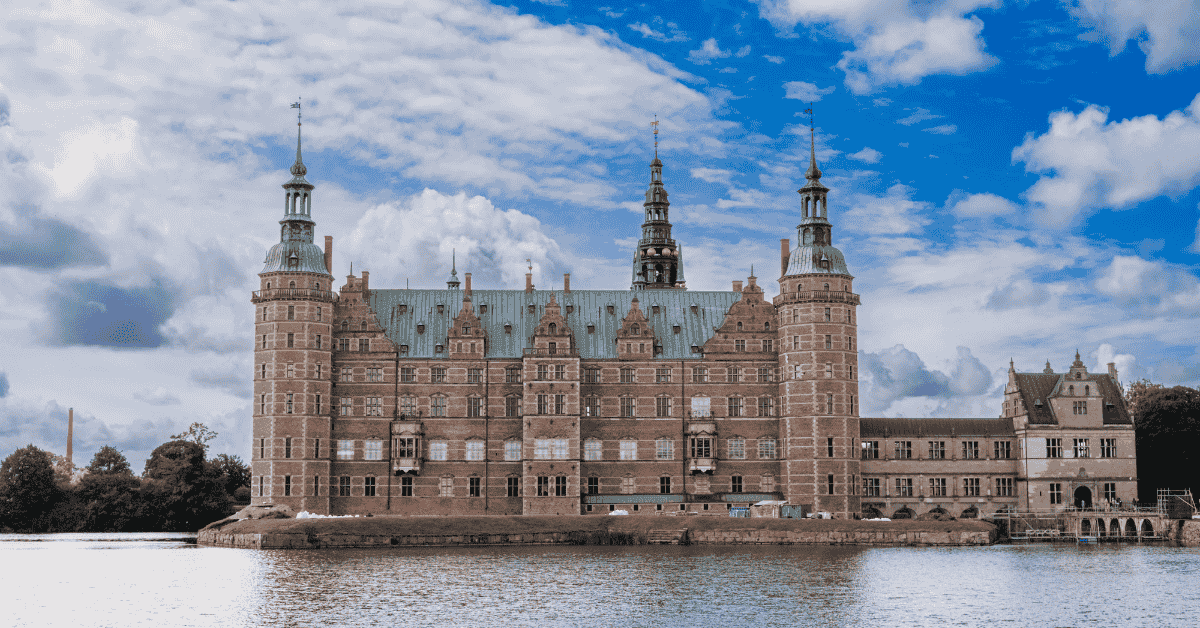Few architectural landmarks in Denmark are as emblematic and captivating as Frederiksborg Castle (Danish: Frederiksborg Slot). Nestled in the scenic town of Hillerød, it lies just 40 kilometers north of Copenhagen. As such, this stunning structure is a crowning achievement of Danish Renaissance architecture and history. Constructed on three islets on Castle Lake, Frederiksborg Castle showcases stunning history and artistry. Therefore, it remains an indispensable part of Denmark’s rich cultural heritage.
- Frederiksborg Castle: An architectural icon constructed in the early 17th century by King Christian IV. It exemplifies Danish Renaissance architecture and serves as a symbol of royal power.
- Historical and Cultural Importance: The castle was a royal residence and the site of Danish monarchs’ coronations. Thereby cementing its role in Denmark’s political and ceremonial history.
- Art and Architecture Showcase: Home to elaborate Renaissance decorations, frescoes, and Denmark’s oldest organ. It also houses the National History Museum with art spanning over 500 years.
- Renaissance Gardens and Grounds: The reconstructed Baroque Garden reflects 18th-century design with manicured hedges, pathways, and fountains. It offers a tranquil blend of art and nature.
The Grandeur and Significance of Frederiksborg Castle
Frederiksborg Castle, known as the “Versailles of the North,” is a true architectural masterpiece. In fact, it symbolizes the Danish monarchy’s power and influence during the Renaissance period. Built in the early 17th century by King Christian IV, the castle served as a royal residence for over a century. The structure was completed in 1620 after four years of meticulous construction. As a result, it stood as a fortress of elegance, reflecting the vision of a prominent Danish king. It spreads across an impressive three islets connected by bridges that add to its picturesque charm.
The castle’s architectural splendor is matched by its historical significance. It was the site of numerous important events, including the coronation ceremonies of the Danish kings and queens from 1671 until 1840. This tradition cemented Frederiksborg Castle’s role as a keystone in the ceremonial and political life of Denmark.
A Showcase of Renaissance Artistry
Frederiksborg Castle is renowned not just for its historical importance but also for its intricate architectural and artistic details. The castle is a rich tapestry of Renaissance art, showcasing elaborate decorations, stunning frescoes, and intricately crafted woodwork. Upon entering, visitors are greeted by the grandeur of the Chapel of Frederiksborg, adorned with exquisite gilding and ceiling paintings that captivate and enthrall. The chapel also houses Denmark’s oldest surviving organ, installed in 1610, adding a prestigious auditory element to the visual spectacle.
The castle also houses the National History Museum, founded in 1878. Since then, it has chronicled over 500 years of Danish history through art and iconic artifacts. The museum features works by renowned artists like Carl Bloch and Jørgen Sonne. Consequently, it offers vivid insight into Denmark’s past, bringing history to life within the castle walls.

Gardens and Grounds: An Oasis of Renaissance Design
Beyond the castle, the Baroque Garden, reconstructed in the 1990s to reflect its original 18th-century design, provides a serene retreat into nature. Designed by Johan Cornelius Krieger, it represents an era of meticulous craftsmanship and symmetry. The terraced gardens feature trimmed hedges, intricate pathways, and elegant fountains. In contrast, they showcase Renaissance elegance beside the castle’s strong, imposing walls. For art and history enthusiasts, the castle and its surroundings create a harmonious blend of culture, nature, and history, presenting an ideal archetype of Renaissance extravagance.
The Cultural Significance of Frederiksborg Castle
Frederiksborg Castle is more than a historical relic; it is a living embodiment of Denmark’s cultural heritage and identity. Its walls echo the sentiments of eras gone by, reminding visitors of the grandeur and the fleeting nature of power and monarchy. As a center piece of national pride, the castle has stood the test of time, witnessing pivotal moments in history while preserving the art, religion, and politics that have shaped Denmark.
Furthermore, its restoration after the devastating fire of 1859 is a testament to the resilience and dedication to cultural preservation. The rebuilding of Frederiksborg Castle showcased the skillful blending of new and old techniques and materials, allowing for a restoration that maintained the castle’s historic authenticity while embracing modern preservation methods.
With its breathtaking blend of history, art, and architecture, Frederiksborg Castle remains an iconic treasure of Denmark, capturing the imaginations of visitors and leaving an indelible mark on all who walk its hallowed halls.
Visiting Frederiksborg Castle: A Journey Through History
Venturing to Frederiksborg Castle is not just a visit but an invitation to journey through Denmark’s illustrious past. Open throughout the year, this magnificent site welcomes hundreds of thousands of visitors annually, all eager to bask in its regal beauty and cultural significance. Whether you’re captivated by Danish history, enthralled by Renaissance architecture, or seeking an enchanting day trip from Copenhagen, Frederiksborg Castle offers a remarkable experience for all.
When to Visit Frederiksborg Castle
Frederiksborg Castle is accessible all year round, with each season offering a unique perspective and charm. From April through September, the castle operates from 11:00 AM to 4:00 PM, allowing plenty of daylight for exploration. The lush gardens burst into full bloom during spring and summer, offering vibrant displays of flora against the castle’s stately backdrop. The Baroque Garden, with its meticulously maintained terraces and ornamental sections, is particularly enchanting during these warmer months.
Winter reveals a different, serene beauty. The grounds become quieter, and the castle’s interiors provide a cozy refuge from the Danish chill. These months often see fewer tourists, granting visitors a more intimate experience. However, the daylight hours are shorter, so plan accordingly to maximize your time exploring the interiors and exhibitions.
Getting There: A Convenient Trip from Copenhagen
Frederiksborg Castle is conveniently located about 40 kilometers from Copenhagen, making it an ideal destination for a day trip. Visitors can reach Hillerød, where the castle is situated, by taking a train from Copenhagen Central Station. The ride is approximately 40 minutes long and provides a scenic journey through the Danish countryside, offering picturesque views that are a prelude to the castle’s splendor.
Upon arrival in Hillerød, the castle is a pleasant 20-minute walk from the train station. Follow the well-marked paths through the charming town, allowing you to soak in the local atmosphere before reaching the striking beauty of Frederiksborg Castle.
Tips for Visiting Frederiksborg Castle
To make the most of your visit to Frederiksborg Castle, here are some helpful tips and considerations:
Plan Your Visit: While the castle can be explored in a few hours, allocating a full day allows you to delve deeply into the museum’s extensive collections and the intricate details of the castle’s architecture. Additionally, join one of the guided tours that provide deeper insights into its historic tapestry.
Purchase Tickets Online: To save time upon arrival, consider purchasing your admission tickets online through the castle’s official website. This step not only speeds up access but also provides information on any special exhibitions or events during your visit.
Wear Comfortable Footwear: Exploring the vast grounds and multiple levels of the castle involves a significant amount of walking. Comfortable shoes are a must to fully enjoy the experience without discomfort.
Explore Surrounding Attractions: Take advantage of your time in Hillerød by exploring nearby attractions, such as the scenic Gribskov Forest or the quaint local shops and cafes. These additional stops enrich your visit and provide a broader taste of the area’s offerings.
Photography Opportunities: Don’t forget your camera! Frederiksborg Castle offers numerous photo opportunities, from the ornate rooms and sweeping views of the gardens to the stunning reflections of the castle’s facade in the tranquil waters of Castle Lake.
Visiting Frederiksborg Castle is a captivating experience that offers a window into Denmark’s rich past and showcases the art and architecture of a bygone era. A well-planned trip can unveil the many layers of history and culture that make this site a national treasure.
Conclusion: The Timeless Allure of Frederiksborg Castle
Frederiksborg Castle stands as a monumental testament to Denmark’s rich cultural and historical heritage, seamlessly bridging the passageways of time with its Renaissance grandeur and artistic treasures. This architectural marvel, set by Castle Lake, captivates both tourists and historians with its beauty. Moreover, it offers a unique glimpse into Danish royal opulence and the nation’s evolving story. You might admire its architecture, explore the museum, or enjoy the peaceful Renaissance gardens. Either way, Frederiksborg Castle delivers an enriching and inspiring experience.
Summary
– Architectural Marvel: Built in the early 17th century by King Christian IV, Frederiksborg Castle showcases the finest of Danish Renaissance architecture.
– Historical Significance: As the site of the coronation of Danish monarchs and a residence for royalty, its historical and cultural importance is unparalleled.
– A Tapestry of Art: Home to the National History Museum, the castle offers vast collections of historic artwork and portraits chronicling over 500 years of Danish history.
– Enchanting Gardens: The Baroque Garden, a harmonious blend of horticultural beauty and Renaissance design, offers serene elegance to the castle grounds.
– Accessible Exploration: Located 40 km from Copenhagen, it is an accessible and enriching day trip with well-planned transportation routes and ample facilities for visitors.
FAQ about Frederiksborg Castle
1. What is the best time to visit Frederiksborg Castle?
The best time to visit is during spring and summer (April to September) when the gardens are in full bloom. However, winter offers a quieter and cozy experience, ideal for exploring the castle’s interiors.
2. How can I get to Frederiksborg Castle from Copenhagen?
You can reach the castle via a 40-minute train ride from Copenhagen Central Station to Hillerød, followed by a 20-minute walk to the castle.
3. Are guided tours available at Frederiksborg Castle?
Yes, guided tours are available and highly recommended to gain deeper insights into the castle’s history and architecture. Check the castle’s official website for scheduling and booking details.
4. Is photography allowed inside the castle?
Photography is allowed, but be mindful of any areas that might have specific restrictions. The castle and its surroundings offer excellent photo opportunities.
5. How much time should I allocate for visiting Frederiksborg Castle?
It’s advisable to allocate at least half a day to explore the castle, museum, and the gardens thoroughly.
6. Can I purchase tickets online?
Yes, we recommend purchasing tickets online for convenience and to avoid long queues upon arrival.
7. What facilities are available for visitors?
The castle provides amenities such as cafes, restrooms, and a gift shop. The grounds are also accessible for visitors requiring additional assistance.
8. Is Frederiksborg Castle kid-friendly?
Absolutely, the castle and its museum offer child-friendly tours and activities, making it an educational and engaging outing for families.
With its blend of historical grandeur and cultural significance, Frederiksborg Castle remains a cornerstone of Denmark’s heritage, offering a rich tapestry of experiences for visitors from around the world. Whether you’re an art enthusiast, history buff, or simply in search of beauty, Frederiksborg Castle is a must-visit destination that promises to leave you inspired and awed.







